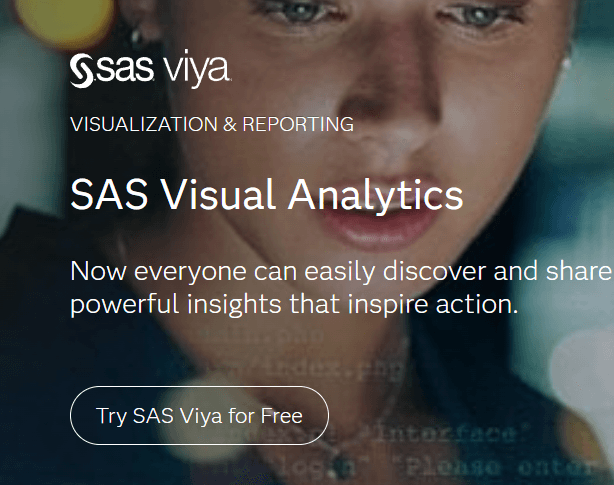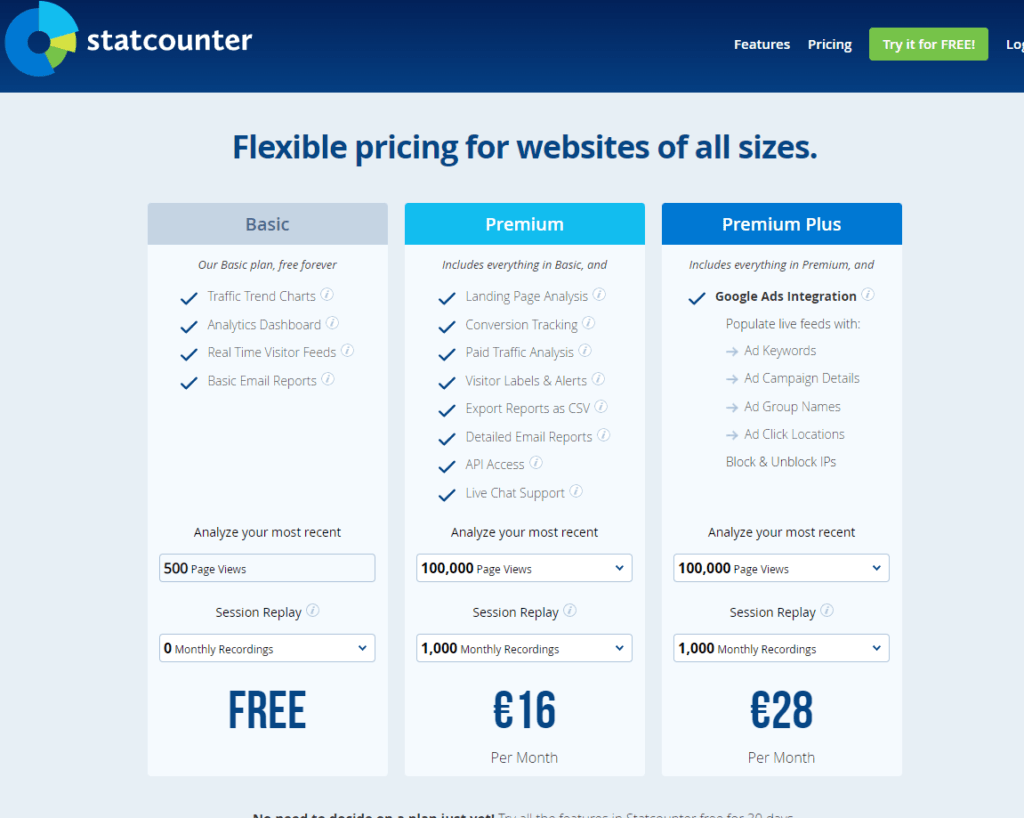Navigating the vast sea of analytics tools can feel like charting unknown waters, with SAS Visual Analytics and Statcounter serving as two prominent lighthouses guiding the way. While both shine their lights on the data-driven decisions path, they illuminate different courses. Today, we’re embarking on a journey to explore these tools, starting with a dive into their user interface and ease of use. This comparison aims to help you decide which beacon—SAS Visual Analytics or Statcounter—is right for your voyage.
| SAS Visual Analytics | Statcounter |
|---|---|
 | |
| G2 Score -4.4 out of 5 | G2 Score -4.3 out of 5 |
| TrustRadius Score -8.4 out of 10 | TrustRadius Score -9.0 out of 10 |
User Interface and Ease of Use: Steering the Ship
In the realm of data analytics, the user interface (UI) and overall ease of use of a tool are like the helm of a ship, determining how smoothly you can navigate through the data seas. Let’s see how SAS Visual Analytics and Statcounter fare in providing a user-friendly experience.
SAS Visual Analytics: The Sophisticated Vessel
SAS Visual Analytics is akin to a sophisticated vessel equipped with an array of advanced navigational instruments. It offers a comprehensive suite of analytics features designed to handle complex data analysis. This tool is built for depth, allowing users to delve into detailed data exploration, predictive analytics, and intricate reporting.
The UI of SAS Visual Analytics, while robust, is designed with the professional analyst in mind. It offers a broad array of visualization options, data manipulation tools, and custom reporting capabilities. This sophistication, however, means there’s a steeper learning curve. New navigators might find themselves taking a bit longer to get accustomed to the controls, but for those who invest the time, SAS Visual Analytics reveals a world of insights beneath the surface.
Statcounter: The Agile Sailboat
Statcounter, on the other hand, is like an agile sailboat, designed for speed and ease of navigation. It provides website analytics with a focus on real-time data, offering users a straightforward and intuitive interface. Statcounter is particularly favored by small to medium-sized businesses and bloggers who need to quickly understand website traffic, visitor behavior, and performance without getting bogged down in complexity.
With Statcounter, setting up and starting your analytics journey is a breeze. The tool offers clear, easily navigable dashboards that provide immediate insights into key metrics like page views, sessions, and bounce rates. While it may not dive as deep as SAS Visual Analytics, Statcounter makes up for it in accessibility and ease of use, ensuring even those with little to no analytics experience can steer their website to success.
Pricing: Charting the Financial Course
The pricing structure of an analytics tool is akin to a map that guides businesses to make informed decisions about their investment in data-driven navigation tools. It’s crucial for this map to be clear, allowing businesses to anticipate costs and align them with expected value. Here’s how SAS Visual Analytics and Statcounter outline their financial landscapes.
SAS Visual Analytics: The Customizable Expedition

SAS Visual Analytics offers a pricing journey that is as comprehensive and robust as its analytical capabilities. It operates on a licensing model, which is highly customizable based on various factors such as the scale of deployment, number of users, and specific features required. This model can include upfront costs for software licenses and ongoing costs for support and maintenance.
The investment in SAS Visual Analytics is significant, reflecting its position as an enterprise-level tool designed for deep, complex data analysis. Organizations considering SAS Visual Analytics need to engage in detailed discussions with SAS representatives to tailor a package that meets their specific needs and budget. This journey, while potentially costly, is marked by the promise of unlocking extensive analytical territories, offering value that can far exceed the investment for businesses ready to delve deep into their data.
Statcounter: The Clear Sailing Plan

In contrast, Statcounter offers a clear and straightforward pricing model, designed like a well-marked nautical chart for businesses navigating the digital analytics seas. It provides a freemium model where basic web analytics features are available for free, with limitations on log size and the historical data accessible. For more advanced features, detailed reporting, and longer data history, Statcounter offers tiered premium plans based on the volume of page views.
This transparent, scalable pricing makes Statcounter an attractive option for small to medium-sized businesses, bloggers, and e-commerce sites that need essential web analytics without a hefty investment. The ability to start with a free plan and scale up as needed allows businesses to manage costs effectively while still gaining valuable insights into website performance and user behavior.
Integration Capabilities: Casting the Net Wide
In the journey of data analytics, the breadth and ease of integration with other data sources and tools can significantly affect how well a business can consolidate, analyze, and act upon its data. Let’s navigate how SAS Visual Analytics and Statcounter fare in these crucial integration capabilities.
SAS Visual Analytics: The Versatile Fleet
SAS Visual Analytics is like a versatile fleet, equipped to tackle a variety of seas and weather conditions. It offers robust integration capabilities, designed to ingest data from a wide range of sources — from traditional databases and cloud storage solutions to third-party platforms. SAS’s prowess in handling vast datasets and complex data structures makes it an excellent choice for enterprises that rely on a diverse data ecosystem.
The platform’s ability to integrate with both SAS and non-SAS environments means businesses can create a unified view of their data landscape, bringing together disparate data sources for comprehensive analysis. However, harnessing these capabilities can sometimes require technical expertise, as setting up these integrations to ensure they run smoothly might involve a deep dive into both the data and the tools involved.
Statcounter: The Swift Single Vessel
In contrast, Statcounter operates more like a swift single vessel, designed for speed and agility within its specific domain. Its integration capabilities are primarily focused on web analytics, with an emphasis on ease of use and quick setup. Statcounter offers straightforward integration with websites, including those hosted on popular platforms like WordPress, Shopify, and Wix, making it a go-to choice for small businesses, bloggers, and e-commerce sites.
While Statcounter excels in its quick deployment and the immediate value it provides in website analytics, its integration capabilities are naturally more limited compared to a comprehensive analytics platform like SAS Visual Analytics. For businesses looking primarily for website performance insights without the need for extensive data consolidation from multiple sources, Statcounter’s streamlined approach is highly appealing.

Related: Check out our free SEO suite

Real-Time Analytics: Harnessing the Power of the Moment
Real-time analytics is like having a lookout perched at the crow’s nest, providing immediate updates on approaching trends and insights, enabling businesses to make swift, informed decisions. Here’s how SAS Visual Analytics and Statcounter perform in delivering these timely insights.
SAS Visual Analytics: The Commanding View
SAS Visual Analytics provides a commanding view from the crow’s nest, offering powerful real-time analytics capabilities that allow businesses to monitor, analyze, and react to data as it’s collected. With its advanced analytics engine, businesses can set up dashboards that update dynamically, offering immediate insights into operational performance, customer behavior, and market trends.
This capability is particularly valuable for large enterprises or organizations dealing with high volumes of data across various channels. SAS Visual Analytics enables these organizations to detect patterns, identify opportunities, and mitigate risks as they happen, ensuring they’re always ahead of the wave.
However, harnessing these real-time capabilities to their fullest potential may require a sophisticated setup and a crew skilled in data analytics, making it more suited for organizations with the resources to invest in such expertise.
Statcounter: The Agile Lookout
On the other hand, Statcounter acts as the agile lookout, offering real-time web analytics that’s focused, straightforward, and incredibly user-friendly. It excels in providing immediate insights into website traffic, visitor behavior, and engagement metrics, allowing website owners and digital marketers to understand how users interact with their sites from moment to moment.
Statcounter’s real-time reporting enables quick decisions on content, marketing strategies, and website design, making it an essential tool for small to medium-sized businesses, bloggers, and e-commerce sites looking to optimize their digital presence without the need for complex analytics setups.
While its focus is narrower compared to SAS Visual Analytics, Statcounter’s agility and ease of use in providing real-time web analytics make it a valuable tool for those whose primary concern is understanding and improving the online user experience.
Data Security and Compliance: Fortifying Your Vessel
The security of an analytics tool encompasses not just the protection of data from unauthorized access, but also the tool’s adherence to global data privacy laws and regulations. Here’s how our contenders ensure their users’ voyages are both secure and compliant.
SAS Visual Analytics: The Fortified Galleon
SAS Visual Analytics, with its longstanding reputation in the analytics world, is like a fortified galleon, equipped with layers of defense against the high seas of digital threats. SAS provides comprehensive security features including data encryption at rest and in transit, user authentication, and detailed access controls, ensuring that data is accessible only by authorized personnel.
Moreover, SAS’s global presence means it is acutely aware of the need to comply with a plethora of data protection regulations such as GDPR in Europe, CCPA in California, and other regional laws. SAS Visual Analytics is designed with these considerations in mind, providing features that help businesses adhere to these regulations, from data anonymization to audit trails that track data access and usage.
Statcounter: The Agile Cutter
Statcounter, akin to an agile cutter, offers a nimble approach to data security and compliance, tailored to its role as a web analytics tool. It ensures data security through encryption and secure data centers, safeguarding information as it navigates the digital realm. Statcounter also provides options for website owners to comply with GDPR and other privacy regulations, such as cookie consent features and the ability to anonymize visitor IP addresses.
While Statcounter’s security measures are robust for its scope of web analytics, its focus on website traffic data means its security and compliance features are streamlined compared to the broad, enterprise-focused capabilities of SAS Visual Analytics. For small to medium-sized businesses and digital marketers, Statcounter offers a balanced blend of security and ease of use, ensuring their digital analytics journeys are both secure and compliant with minimal complexity.
Conclusion
As we draw the sails and anchor at the end of our exploratory journey comparing SAS Visual Analytics and Statcounter, we’ve navigated through a range of crucial aspects that distinguish these two analytics tools. From their ease of use and integration capabilities to pricing structures and the critical realms of data security and compliance, each platform offers unique strengths tailored to different types of voyagers on the data analytics sea.
READ NEXT:
- SAS Visual Analytics vs Segment: The Best Analytics Tool for You
- Bitrix24 vs Vtiger: The Best CRM Tool for You
- SugarCRM vs Vtiger: The Best CRM Tool for You
- Vtiger vs Agile CRM: The Best CRM Tool for You
- MicroStrategy vs Mixpanel: The Best Analytics Tool for You
- 11 Marketing Analytics Tools to Elevate Your Data-Driven Strategies
- 29+ Digital Analytics Software to Skyrocket Your Digital ROI






















Comments are closed.